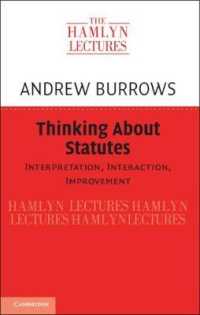- ホーム
- > 洋書
- > 英文書
- > Science / Mathematics
Full Description
The 8th edition of this acclaimed book provides practical coverage of electric circuits. Well-illustrated and clearly written, the book contains a design and page layout that enhances visual interest and ease of use. The organization provides a logical flow of subject matter and the pedagogical features assure maximum comprehension. Some key features include: "Symptom/Cause" problems, and exercises on Multisim circuits. Key terms glossary-Furnished at the end of each chapter. Vivid illustrations. Numerous examples in each chapter-Illustrate major concepts, theorems, and methods. MARKET: For professionals with a career in electronics, engineering, technical sales, field service, industrial manufacturing, service shop repair, and/or technical writing.
Contents
Part I DC CircuitsChapter 1 Quantities and Units1-1 Scientific and Engineering Notation1-2 Units and Metric Prefixes1-3 Metric Unit Conversions1-4 Measured Numbers1-5 Electrical SafetyChapter 2 Voltage, Current, and Resistance2-1 Atoms2-2 Electrical Charge2-3 Voltage2-4 Current2-5 Resistance2-6 The Electric Circuit2-7 Basic Circuit MeasurementsApplication Assignment: Putting Your Knowledge to WorkChapter 3 Ohm's Law, Energy, and Power3-1 Ohm's Law3-2 Application of Ohm's Law3-3 Energy and Power3-4 Power in an Electric Circuit3-5 The Power Rating of Resistors3-6 Energy Conversion and Voltage Drop in a Resistance3-7 Power Supplies3-8 Introduction to TroubleshootingApplication Assignment: Putting Your Knowledge to WorkChapter 4 Series Circuits4-1 Resistors in Series4-2 Total Series Resistance4-3 Current in a Series Circuit4-4 Application of Ohm's Law4-5 Voltage Sources in Series4-6 Kirchhoff's Voltage Law4-7 Voltage Dividers4-8 Power in Series Circuits4-9 Voltage Measurements4-10 TroubleshootingApplication Assignment: Putting Your Knowledge to WorkChapter 5 Parallel Circuits5-1 Resistors in Parallel5-2 Total Parallel Resistance5-3 Voltage in a Parallel Circuit5-4 Application of Ohm's Law5-5 Kirchhoff's Current Law5-6 Current Dividers5-7 Power in Parallel Circuits5-8 TroubleshootingApplication Assignment: Putting Your Knowledge to WorkChapter 6 Series-Parallel Circuits6-1 Identifying Series-Parallel Relationships6-2 Analysis of Series-Parallel Resistive Circuits6-3 Voltage Dividers with Resistive Loads6-4 Loading Effect of a Voltmeter6-5 The Wheatstone Bridge6-6 Thevenin's Theorem6-7 The Maximum Power Transfer Theorem6-8 The Superposition Theorem6-9 TroubleshootingApplication Assignment: Putting Your Knowledge to WorkChapter 7 Magnetism and Electromagnetism7-1 The Magnetic Field7-2 Electromagnetism7-3 Electromagnetic Devices7-4 Magnetic Hysteresis7-5 Electromagnetic Induction7-6 Applications of Electromagnetic InductionApplication Assignment: Putting Your Knowledge to WorkPart II AC CircuitsChapter 8 Introduction to Alternating Current and Voltage8-1 The Sinusoidal Waveform8-2 Sinusoidal Voltage Sources8-3 Voltage and Current Values of Sine Waves8-4 Angular Measurement of a Sine Wave8-5 The Sine Wave Formula8-6 Analysis of AC Circuits8-7 Superimposed DC and AC Voltages8-8 Nonsinusoidal Waveforms8-9 The OscilloscopeApplication Assignment: Putting Your Knowledge to WorkChapter 9 Capacitors9-1 The Basic Capacitor9-2 Types of Capacitors9-3 Series Capacitors9-4 Parallel Capacitors9-5 Capacitors in DC Circuits9-6 Capacitors in AC Circuits9-7 Capacitor ApplicationsApplication Assignment: Putting Your Knowledge to WorkChapter 10 RC Circuits10-1 Sinusoidal Response of RC Circuits10-2 Impedance and Phase Angle of Series RC Circuits10-3 Analysis of Series RC Circuits10-4 Impedance and Phase Angle of Parallel RC Circuits10-5 Analysis of Parallel RC Circuits10-6 Analysis of Series-Parallel RC Circuits10-7 Power in RC Circuits10-8 Basic Applications10-9 TroubleshootingApplication Assignment: Putting Your Knowledge to WorkChapter 11 Inductors11-1 The Basic Inductor11-2 Types of Inductors11-3 Series and Parallel Inductors11-4 Inductors in DC Circuits11-5 Inductors in AC Circuits11-6 Inductor ApplicationsApplication Assignment: Putting Your Knowledge to WorkChapter 12 RL Circuits12-1 Sinusoidal Response of RL Circuits12-2 Impedance and Phase Angle of Series RL Circuits12-3 Analysis of Series RL Circuits12-4 Impedance and Phase Angle of Parallel RL Circuits12-5 Analysis of Parallel RL Circuits12-6 Analysis of Series-Parallel RL Circuits12-7 Power in RL Circuits12-8 Basic Applications12-9 TroubleshootingApplication Assignment: Putting Your Knowledge to WorkChapter 13 RLC Circuits and Resonance13-1 Impedance and Phase Angle of Series RLC Circuits13-2 Analysis of Series RLC Circuits13-3 Series Resonance13-4 Series Resonant Filters13-5 Parallel RLC Circuits13-6 Parallel Resonance13-7 Parallel Resonant Filters13-8 ApplicationsApplication Assignment Putting Your Knowledge to Work Chapter 14 Time Response of Reactive Circuits14-1 The RC Integrator14-2 Response of RC Integrators to a Single Pulse14-3 Response of RC Integrators to Repetitive Pulses14-4 Response of RC Differentiators to a Single Pulse14-5 Response of RC Differentiators to Repetitive Pulses14-6 Response of RL Integrators to Pulse Inputs14-7 Response of RL Differentiators to Pulse Inputs14-8 Applications14-9 TroubleshootingApplication Assignment: Putting Your Knowledge to WorkChapter 15 Transformers15-1 Mutual Inductance15-2 The Basic Transformer15-3 Step-Up and Step-Down Transformers15-4 Loading the Secondary15-5 Reflected Load15-6 Impedance Matching15-7 Nonideal Transformer Characteristics15-8 Tapped and Multiple-Winding Transformers15-9 TroubleshootingApplication Assignment: Putting Your Knowledge to WorkAppendices A Table of Standard Resistor ValuesB Capacitor Color Coding and MarkingC The Current Source, Norton's Theorem, and Millman's TheoremAnswers to Odd-Numbered ProblemsGlossaryIndex








